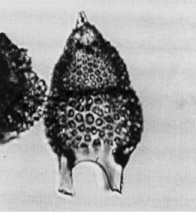 Thyrsocyrtis
(Thyrsocyrtis) rhizodon Ehrenberg
Thyrsocyrtis
(Thyrsocyrtis) rhizodon Ehrenberg Thyrsocyrtis
(Thyrsocyrtis) rhizodon Ehrenberg
Thyrsocyrtis
(Thyrsocyrtis) rhizodon EhrenbergThyrsocyrtis rhizodon Ehrenberg, 1873, p.262; 1875, p.94, pl.12, fig.1; Sanfilippo and Riedel, 1982, p.173, pl.1, figs.14-16, pl.3, figs.12-17 (with synonymy)
General form barrel-shaped to somewhat conical. Cephalis subspherical with few, small pores, bearing conical horn, usually short but in some specimens up to half length of shell. Thorax campanulate to hemispherical, with pores commonly about as wide as intervening bars. Lumbar stricture usually distinct. Abdomen longer than thorax, subcylindrical to somewhat inflated, with pores larger than thoracic and usually quincuncially arranged. Feet tapering from peristome then cylindrical, and terminally stubbily branched or with outwardly directed thorn (Sanfilippo and Riedel, 1982).
Based on 25 specimens. Length excluding horn 140-225 µm, of cephalothorax 55-85 µm, of abdomen 55-100 µm. Maximum breadth 95-130 µm (Sanfilippo and Riedel, 1982).
T. rhizodon differs from T. hirsuta and Theocotyle nigriniae in the terminally branched or thorned feet, and from Thyrsocyrtis bromia in smaller abdominal pores, and from T. robusta in the less rough thorax, less pronounced lumbar stricture and smaller size (Sanfilippo et al., 1985).
This species gradually changes its general shape, through time, from conical to barrel-shaped, the shell wall becoming thicker in later specimens, which causes the collar and lumbar strictures to become less pronounced. The abdomen is usually longer (length of cephalothorax 55-85 µm; of abdomen 55-100 µm) than the thorax, and the pores are 2 to 3 times as large, in later specimens arranged quincuncially. Early forms have a more inflated abdomen, three slender cylindrical feet arising from a poreless abdominal rim, terminally truncate or bluntly pointed, sometimes with an outwardly directed thorn, or occasionally more complicatedly branched. In later specimens the feet are short triangular extensions of the abdominal rim and not branched (Sanfilippo et al., 1985).
This rather long-ranging species occurs in moderate numbers in all oceans from 15°S to 20°N during the middle and late Eocene. Its morphotypic first appearance lies within the Phormocyrtis striata striata Zone. Its morphotypic last appearance lies within the Cryptocarpium ornatum Zone.
T. rhizodon evolved from T. hirsuta and gave rise to T. bromia. T. rhizodon co-occurs with its descendant through the late Eocene.